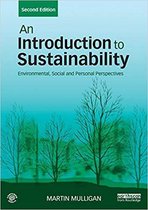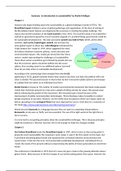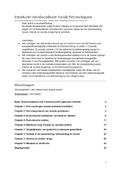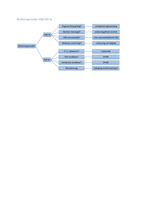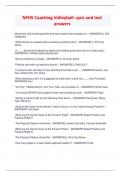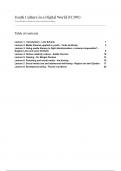Chapter 1
Humans only began thinking about the sustainability as a global challenge recently (1970’s). The
Brundtland report initiated a series of global gatherings and negotiations. At the time of writing of
the Brundtland report failures overshadowed the successes in meeting the global challenge. The
report also laid the fundation of the Earth Summit in Rio (1992). This Summit raised a lot of attention
and led to agreements signed by a lot of countries (Agenda 21, practical things governments could do
for sustainable development). The next successful summit was held in Paris (2015), all the other
summits, such as the Copenhagen summit, did not have the
same global impact as these two. John Elkington introduced the
‘triple bottom line’ model in 1994, which suggested the need
for balance between economic policies, social outcomes and
environmental impacts. This model got turned into the ‘three
sectors’ model representing the challenges of sustainability.
These three sectors sometimes get criticized by people who say
that the economic sphere should be shifted into the social
sphere, thus creating room for an additional sphere ‘personal’
(how do you take action in sustainable development)
According to the communiqué that emerged from the rio+20
(gathering in 2012), global humanity knows what needs to be done, but lacks the political will to do
what is needed. The assumed answer to that is that we don’t encounter global systems and changes
at a global level but rather at an individual local level.
Rachel Carson is known as ‘the mother of modern environmental movement (her book made people
realize that chemicals sprayed on crops were capable of killing animals far away). She passed away
before witnessing the growth of the movement, this movement got a boost because of the
improvement of global communication technologies. This technology makes it possible to contact
people anywhere at any time. However, we live within local ecosystems where our impact starts (so
before spreading to the ecological flows that were depicted by Carson. (click here for a summary of
her book http://www.supersummary.com/silent-spring/summary/)
Words become keywords in a language because they are open to competing interpretations.
Buzzwords can be seen as ‘fluffy’ and non-essential. The use of the right words at the right time is
key to success.
It is very hard to set guiding principles about the sustainability challenges. This is because principles
might be treated as a ‘tick-box’ exercise, this is not enough to make the changes needed.
Chapter 2
Gro Harlem Brundtland wrote the Brundtland report in 1987, which is seen as the turning point in
giving the word sustainability the meaning it caries today. It wasn’t the first report on this topic, but
it presented disturbing global trends and explained the correlation between environmental and
social factors. It did coin the term ‘environmentally sustainable development, and defined this as
‘meets the needs of the present without compromising the ability of future generations to meet their
needs’.
The conference in Stockholm in 1972 (start of a new era) gave a look on the growing attention about
global ‘limits’, likely because of the first images of our lonely looking planet from space, however the
,Brundtland report deserves credit for making the concept as we know it today. The first space
photo’s were very important in the development of attention for the environment, because it gave
people a new sense of vulnerability while there aren’t any planets like ours close by. The term
‘spaceship Earth’ was created by Sharon Beder, it implies that the earth can be seen as an isolated
spaceship with inbuilt life and support system. The term was picked up by Kenneth Boulding.
Nairobi 1982, attention to need to address the underlying economic and social causes of
environmental problems.
Donald Worster claims that many literature pieces were key to changes in human thinking (i.e
Darwin’s work, Gilbert White (responsible for triggering a ‘natural history’ movement and Henry
Devid Thoreau.
A team of scientists (lead by Donella Meadows) commissioned a study on the implications that we
live on a finite and vulnerable planet. They used modelling techniques and put forward the argument
that there is a limit to growth because of the planet’s finite resources. The modelling techniques
were however not top-notch, and that allowed critics to say that the predictions were too alarmist.
(the model didn’t take into account that there could be new discovery of resources/ resource usage.
So the approach has been dismissed as neo-Mathusian referring to Thomas Malthus. Meadows
responded by saying that the problems in predicting the future should not detract the underlying
argument (the human consumption will at one point be more than the resources on earth.
Rio+20 might not have had the same impact as the summit in Rio in 1992, but it did lead to the fact
that the host nation Brazil was able to play a big role in ensuring that the future we want contained
sharp criticisms of the lack of progress made since the summit in 1992. Also other rising countries as
China and India played a larger role in this summit.
The 1992’s summit attributed to the fact that global political leaders managed to negotiate a
protocol for phasing out the use of ‘aerosol’ gases to protect the ozone layer. Concerns about the
ozone thinning were sparked by a study in 1985 which suggested that the ‘hole’ was getting bigger.
CFCs gases (commonly used in aerosol sprays were contributing to the ozone layer because the break
down under UV radiation to chorine molecules that attack the ozone layer. Agreements and funds
were set up and the ozone depletion has been significantly contained and the fears diminished. This
success shows that effective global action can be taken when there is enough pollical will. This
success also might have led to an unrealistic expectation in other environmental questions, for
example the human-induced climate change conference in Kyoto in 1997. Also, the Copenhagen
summit failed the expectations, but sparked the effort to ensure that the next summit (Paris climate
summit) would make more progress. Here the agreement of keeping the global warming below 1.5
degrees was made. After the summit, China and the USA pushed each other to set even more
targets. (these are the two most important greenhouse gas emitters)
In New York (2000) were the eight Millennium Development Goals made, which were focused on
lessening the extreme poverty, hunger and preventable diseases. In 2015 these eight goals were
extended to the famous 17 Sustainable Development Goals (SDGs) to be achieved by 2030.
Big sustainability challenges can’t be taken by national or even sub-national governments, it has to
be done globally, this also because of the economic globalization (because of the rising dominance of
multinational corporations). We live in a world where global forms of governance are still weak,
while new communication techniques make it possible to have a strong global governance. But as we
know from Carson’s book, the human impact start locally, so we have to develop new ways to link
local and global action for change.
, Paul Hawken argued that the movement for sustainable living is already gathering momentum
without a lot of attention. This is because of a loosely networked array of organizations around the
world, this combined with the communication technologies enable them to have a sense of
connection and thus being a part of a movement. It is yet unclear of much of a political will this
movement can create. Greenwashing can be a problem in gaining pollical will because corporations
will make it seem like they are ‘greener’ than they actually are and thus creating the elusion of
progress in sustainable challenges.
Herman Daly made a set of sustainability principles based on the interpretation of books:
- Limit the human scale to that which is within the earth’s capacity
- Ensure that technological progress is efficiency increasing rather that throughput increasing
- For renewable resources, harvesting rates should not exceed regeneration rates and waste
emissions should not exceed the assimilative capacities of receiving environments
- Non-renewable resources should be explored no faster than the rate of creation of
renewable resources.
Although these principles look good, they are difficult for individuals to undertake action upon.
Chapter 3:
The rapidly growing nations as India and China are taking us even deeper into a crisis of
unsustainable consumption. A bunch of shocking statistics let us know how bad the current situation
is (i.e. meat production quadrupled over a period of 50 years and the energy extracted from multiple
fuel sources doubled between 1971 and 2005).We have already passed the capacity of the planet to
sustain our consumption of energy and raw materials.
Overconsumption has negative effects on the planet, it generates waste streams which have negative
environmental and human health impacts. A lot of attention is being focused on the negative
environmental costs of overconsumption, but addictive consumption can also have negative health
impacts as obesity.
According to Gilles Lipovetsky we are living in an era of hyperconsumption which is according to him
the third phase in the development of ‘consumer capitalism’. With the first phase starting around
1880 with the proliferation of standardized goods sol at low prices, and the second phase focusing on
a rapid global increase in the availability of consumer goods.
The hyperconsumption emphasis the individual consumption and thus causing a ‘veritable explosion
of individualism’. Terms as ‘emotional consumerism’ and ‘hedonistic consumerism’ are being used to
suggest that hyperconsumption can easily become a way of life. Hyperconsumption is not evenly
spread throughout the world, most western countries have a bigger per capita consumption in
comparison to other countries.
A con of hyperconsumption is the amount of the plastic being used, this plastic gets thrown away and
mostly ends up in either landfills or oceans.
Many families are going to the outer margins of cities to find their dream home, this has as effect
that people have to drive longer to get to work, friends, family and shopping (which increases carbon
emission) this leads to a lower connection to the local community and neighbors. This phenomenon
is called cocooning, where people spend most non-working time inside their own home (electronic
devices also keeps them more inside their own home). Staying in their own home has as
consequence that it is easier for them to ignore for example the question of where waters comes

